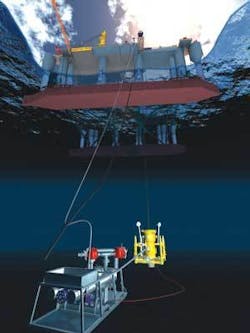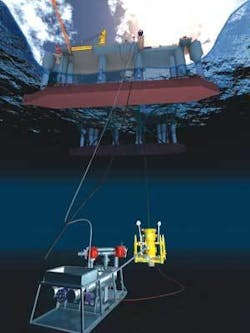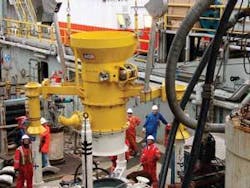Riserless mud system solves North Sea drilling problem
A new riserless drilling technology that the users say recovers and reuses drilling fluid, improves hole stability, well control, saves time and money, and eliminates discharges into the sea has been used in a commercial operation in the North Sea for the first time. Total E&P UK used the Ability Group’s riserless mud removal system on its Jura West 3/15-10 North Sea exploration well.
Total’s exploration well was drilled using the semisubmersible rigSedco 714 in 113 m of water. This was the first time the RMR had been used on that rig, and the experience is expected to result in added future well cost savings.
Total used the RMR to avoid having to run a pin connector to deal with shallow gas mitigation. The technology allowed Total to save time over the pin connector method. It allows a 26-in. hole to be drilled initially rather than having to under-ream the 17 1⁄2 in. pilot hole under the marine riser to use a pin connector. Additionally, if shallow gas is encountered using a pin connector, the gas influx is diverted at surface. The RMR system allows the rig to move off station for safety. The operation required minimal online time to rig up as most of the installation is done offline. Total had no non-productive time in more than four days of operation.
“We have found that RMR provides a step shift in drilling performance,” said Mike McMahon, Total Drilling Operations superintendent. “Not only does the system create greater borehole stability and have significant environmental benefits, we found the system also saves us time and money. Total now plans to use the technology in future wells where the conditions warrant.”
The RMR System is a riserless dual-gradient technology used to drill the top hole or open hole sections of a subsea well. The system uses a suction module to pick up the mud and drill cuttings at the seabed. Mud and cuttings are pumped back to the surface along an 8-in. diameter flexible hose, enabling the drilling fluid to be reused, and providing for controlled handling and disposal of cuttings.
Previously, the only technology available for top hole drilling of subsea wells was sacrificial mud systems that discharge mud and cuttings into the sea. Because drilling fluids can be expensive and discharge often is prohibited in some ecologically sensitive areas, the sea discharge system may not be viable, possibly leading to the abandonment of wells. The RMR technology avoids discharges into to the sea and can recirculate the drilling fluid.
The system is useful in areas associated with shallow geohazards and instability such as soft clays, shallow water flow, and shallow gas where specialized drilling fluids are needed for borehole stability. The system recycles drilling fluids, so mud can be recirculated during drilling. Other advantages of the RMR technology include rapid and accurate kick detection, the ability to push casing depths deeper, the use of fewer casing strings, simplifying casing design, and reducing operating time - typically three to five working days. In deepwater, savings can amount to $1 million per well when including rig time and logistics.
The system’s first successful commercial use was in the Caspian Sea in 2004 for BP in the Azerbi field where the area’s shallow soils had damaged wells in earlier drilling attempts. A heavy silicate mud system was needed to cope with the shallow soils, but using a sacrificial mud system was too expensive and was potentially harmful to the environment. A riser system was out of the question due to the fracture gradient. RMR was the choice because it could recirculate and recycle the heavy drilling mud needed to stabilize the bore hole. A total of 25 wells have been drilled in the Caspian Sea using the technology. The system also has been used off Sakahalin Island on two wells for BP and in the Barents Sea at the Shtokman field for Norsk Hydro.
Using a riser in deepwater presents technical challenges, with the riser subject to high tensions, extreme internal and external pressure, and high levels of fatigue damage in a short duration of time. Perhaps a bigger challenge is accurate well planning. Using a riser in deepwater can exert pressure influences downhole that are difficult to calculate, to plan for, and to counteract.
In the riser pipe, the head of mud that is at the same height as the water column starts to distort the pressure downhole. Riserless drilling that collects the well return at the seabed and pumps it to the surface removes the influence that the mud exerts on the downhole pressure, allowing heavier drilling fluids to be used for greater well control.


